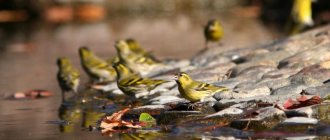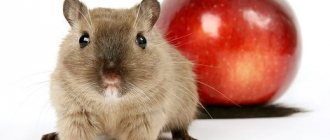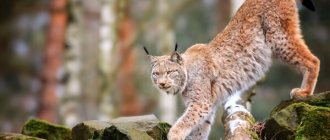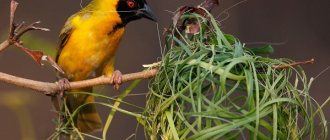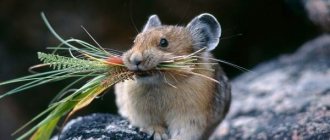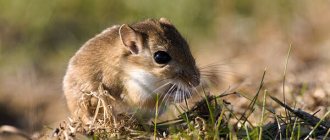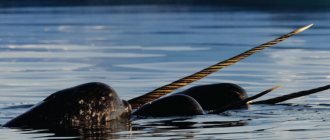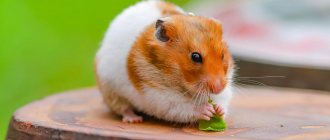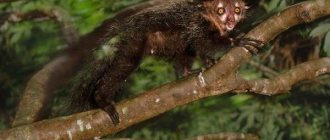In the mountains of New Zealand lives a unique bird - the kea parrot. Its scientific name is nestor (from the Latin Nestor notabilis). Local residents gave him the nickname “Sheep killer,” that is, “sheep killer.” What is this connected with, and why did Nestor get a bad reputation? After reading the article, you will find the answers and also get an idea about the appearance, lifestyle and habits of the parrot. In addition, you will learn about the reproductive characteristics and conservation status of kea.
Appearance
It does not look like its compatriots, it is distinguished by its brown plumage. The shape of the beak resembles a thin, sharp hook. An adult reaches a size of 50 cm and a weight of 1 kg. The feather color is brown-olive, the inner surface of the wings is lined with bright orange plumage with blue lines. The legs are powerful and thick. Eye color is dark brown, almost black.
Strong paws allow you to hold on and move on any surface. The female differs from the male in having a smaller beak. Juveniles have yellow plumage around the eyes and beak. When the predator spreads its wings, you can see a beautiful, motley pattern of multi-colored plumage above the tail.
Accustomed to harsh climates, predators love to swim in icy puddles, play in snowdrifts, and even ride off snow-covered roofs.
Kea is an exceptional parrot
You can find out the name of the bird from it itself: kee-aa, kee-a. The parrot has not yet learned to pronounce the scientific combination Nestor notabilis because no one has given him this task.
Ornithologists call an exception to the rule a bird that is not similar to its African or South American counterparts. Kea parrot , also known as Nestor, is famous locally for his hooligan behavior and impudent disposition. But the bad guy is valued for his intelligence and is protected as an object of the Red Book.
Spreading
Flocks settle in New Zealand. Only in extreme cases can they leave their native land. They fight for life in a family that consists of 10–20 individuals. They survive in harsh climatic conditions in snow-covered rocks at sub-zero temperatures and snowy winds. Therefore, parrots adapt well at home. They do not require special care, but it is not recommended to keep the bird in a cage. A free lifestyle is the key to good health and good mood.
Likes to hunt field rodents.
Tastes could not be discussed
It must be said that kea is a bird with a truly unusual taste. The parrot became the hero of numerous New Zealand legends not only because of its addiction to sheep fat, but also because of its uncontrollable craving for rubber. Moreover, rubber gaskets for car windows are especially popular. A parrot can torment this “delicacy” even while the car is moving, and in order to get rid of the intrusive passenger, drivers increase the speed. One day, a careless motorist left his car on the street overnight. In the morning, he hardly recognized his iron horse - a flock of robbers completely ate the rubber gasket of the windshield, as a result, it simply collapsed inside the car! And since these birds do not disdain foam rubber, they tore all the car seats to shreds, and then started working on the interior trim!
Behavior
The parrot got its name because of the sound it makes: “Kea, Kea!” The predator prefers to spend most of its time in flight. Every day it soars in the air, inspecting the territory, at the same time looking for prey. It is not recommended to hand feed a new parrot. Ornithologists have found that the parrot has an intelligence level on par with crows. They are able to repeat a person’s speech in the same intonation. Dirty animals are often kept at home. It is recommended to buy a small bird, it is easier to teach it to perform simple tricks, and it is possible to learn a short poem. The young parrot quickly begins to communicate and becomes attached to the owner.
The predatory parrot knows how to handle simple objects and easily manipulates sticks and twigs. Skills are aimed at obtaining food. The bird has an extraordinary mind, quick wit, and can open any container with its beak. Moves things from place to place, breaks nuts by throwing them on the ground, can throw a heavy object on a branch so that the fruits fall to the ground. The pet loves to improvise and surprise its owners with new approaches to prey and food. Logicality and an average level of intelligence help the parrot get used to its environment.
Lifestyle
Kea are well adapted to the harsh conditions of life in the mountains. They can be found even at altitudes above 1500 meters above sea level, where there are almost no forests or meadows. Typically, flocks of birds lead a sedentary lifestyle, but in search of food they can descend from the highlands to lower ones. It is worth noting that wild representatives of this species are not at all afraid of people, so they can often be found next to human houses, landfills, and trash cans. They spend the entire day searching for food or soaring high in the clouds.
Thanks to the Maori tribes, Kea got their name, which is similar to the sound they usually make. The Maori claimed that these birds often circled in the mountains before a strong snow storm.
Character and intelligence
New Zealand kea parrots are known for their rowdy, fearless, and violent disposition. Birds calmly fly into houses and look for treats, making a mess in trash cans by opening the lid with their paws on their own. With the help of its tenacious paws, a parrot can easily steal a sandwich or waffle from a gaping tourist in flight mode. The predator is not afraid of people.
Clever parrots can solve simple problems, perform logical puzzles that lead to places of food, can do simple work, are rarely trained, and can open a lock with their beak.
Smart birds get along well at home and quickly get used to their new owners. They cannot be kept in a cage. They are easy to train to the tray.
Intellectual abilities
For decades now, New Zealanders have been practicing their ability to make a mechanism that would be beyond the power of a kea. So far to no avail. Parrots can distinguish colors and solve logical problems with dexterity. Experiments have shown that birds have surpassed primates in skills. Possessing excellent memory, once birds receive food from human hands, they take it for granted. Feeding kea is strictly prohibited.
Legends and rumors surround these amazing creatures, which is why today kea parrots continue to attract more and more tourists. If you liked the article or have something to add, then leave your comments and also join our VKontakte group.
Diet
The predator parrot feeds on raw sheep meat, stems, nuts, roots, worms, fruits, larvae, insects, does not disdain carrion, table waste, eats other people's eggs and chicks. At home, you can feed nuts, peanuts, fruits, roots, leaves, bugs, and midges. If the bird spends most of its time outside the cage, it hunts mosquitoes, midges, and cockroaches.
Cockatoos: natural enemies, population
Cockatoos live in tropical and rainforests, forest edges, savannas and open areas, and are native to Australia, New Guinea and Indonesia. Eggs and chicks are a tasty morsel for many predators. Lizards, including monitor lizards, snakes, rodents and possums that can climb trees find them in hollows. Cockatoos suffer from circovirus beak and feather infections (PBFD). The consequences can be: feathers falling off, weight loss, beak curvature and deterioration in the bird’s general health.
The main threats to the cockatoo population are habitat loss and wildlife trade. People are encroaching on the familiar habitat of cockatoos; due to the cutting down of trees and clearing of the area, the birds are losing their nesting places. This can lead to the aging of the entire population. Old birds do not have the opportunity to reproduce. This means that when they die, the situation will reach a serious reduction in the number of birds.
Illegal catching and further smuggling of parrots, despite the fight and ban, is at a critically high level. The birds are placed in boxes, bamboo tubes, PVC pipes and transported to other countries under cover on international flights. But cockatoo eggs are increasingly being exported; they are much easier to transport by any means.
The cockatoo parrot is protected by the Convention on International Trade in Endangered Species of Wild Fauna (CITES). It restricts the import and export of wild-caught parrots for special licensed purposes.
The article was read by 270
Sheep hunting
Hunting sheep became a favorite pastime of predators. Parrots love to get fat from their skins. The bird chooses the weakest sheep, which lags behind the herd, then lands and hides in the grass to analyze the situation. If there is no person nearby, the bird jumps on the victim’s back, uses its beak to clear the skin of fur, and then eats away at the soft tissue. The animal is slowly dying. The time for hunting sheep begins when grass does not yet grow on the arable land.
Parrots have never eaten meat. But after the arrival of Europeans on the territory of New Zealand, agriculture began. The sheep pasture consumed all the greenery, dooming other inhabitants of the forests and steppes to starvation. Therefore, the struggle for survival began. The natural food chain has moved to another level. Now predators prefer to eat meat waste. Both females and males go hunting; the choice stops at the weak sheep.
Reproduction
The kea bird turns into an adult after 3 years of life. The mating season lasts throughout July and ends in February. The female independently cares for the chicks. The nest is established in rock crevices at a depth of 6-7 meters. To build a nest, the female carries thin twigs, tears down feathers from her body, and makes soft, warm bedding.
At a depth of 6 meters the temperature is 22-25 degrees.
The female's clutch consists of 2-4 eggs, each 4.5 cm in size. The chicks break through the shell after 3 weeks. During the entire period, the female does not fly out of the nest. During incubation, the male flies to the female to clean her feathers, while simultaneously protecting the family from predators and ill-wishers. Birds nest in crevices of high rocks and hollows. The female builds the nests, the male helps strengthen the structure. The bird arranges its home well.
During observations, ornithologists noticed the presence of polygamy. A male can have several families, which he alternately visits and shows courtship to.
After the chicks hatch, the female, together with the male, raises the offspring for 2 months, then flies away from the nest. The male continues the process of feeding and caring for the cubs. After 2.5 months, the chicks of predatory parrots fly well and leave the nest.
Re-adaptation of parrots
Before Europeans arrived on the island, the kea bird ate only insects and plants. Due to the lack of food familiar to parrots, they had to change their diet. This is how mammalian meat appeared on the birds’ menu, the consumption of which granted the green beasts the status of predators. Zoologists call this phenomenon re-adaptation. Fans of the theory of evolution argue that it was re-adaptation that forced freshwater animals to leave their habitat and begin life on land.
Although their appearance makes large parrots look like predators, they were not originally predators. Powerful claws and a sharp beak were given to nestors for the convenience of climbing trees and facilitating the extraction of insects from under stones and bark. Today, large New Zealand parrots use these “devices” to attack small livestock, in particular sheep.


